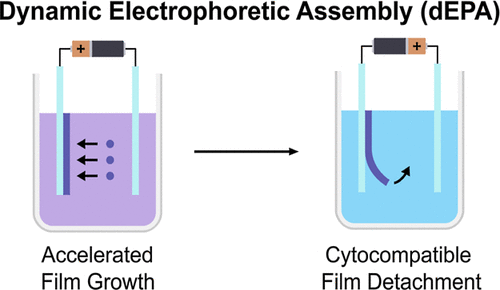当前位置:
X-MOL 学术
›
Chem. Mater.
›
论文详情
Our official English website, www.x-mol.net, welcomes your feedback! (Note: you will need to create a separate account there.)
Dynamic Electrophoretic Assembly of Metal–Phenolic Films: Accelerated Formation and Cytocompatible Detachment
Chemistry of Materials ( IF 8.6 ) Pub Date : 2020-09-02 , DOI: 10.1021/acs.chemmater.0c02171 Gyeongwon Yun 1 , Wongu Youn 1 , Hojae Lee 1 , Sang Yeong Han 1 , Mariana B. Oliveira 2 , Hyeoncheol Cho 1 , Frank Caruso 3 , João F. Mano 2 , Insung S. Choi 1
Chemistry of Materials ( IF 8.6 ) Pub Date : 2020-09-02 , DOI: 10.1021/acs.chemmater.0c02171 Gyeongwon Yun 1 , Wongu Youn 1 , Hojae Lee 1 , Sang Yeong Han 1 , Mariana B. Oliveira 2 , Hyeoncheol Cho 1 , Frank Caruso 3 , João F. Mano 2 , Insung S. Choi 1
Affiliation

|
Material-independent coating has emerged as an advanced tool for interface engineering in numerous applications, including drug delivery, single-cell nanoencapsulation, catalysis, and agrotechnology. Despite remarkable progress made in controlled film formation on solid substrates, the high adhesion of coating species, exemplified by metal–phenolic materials, hinders the film detachment and subsequent formation of freestanding films. In particular, there have been no reports on cytocompatible fabrication of biofriendly freestanding films of metal–phenolic materials and polyphenols, which is required in biomedical engineering and nanomedicine. Considering the high demand for cytocompatible protocols for cytocompatible freestanding films, in this work, we have developed an electrophoresis-based, biocompatible method called dynamic electrophoretic assembly (dEPA) for dynamically and locally regulating the cohesion and adhesion processes of metal–phenolic materials under mild conditions. The locally concentrated cohesive process in dEPA increases the film growth rate by 2–3 orders of magnitude, and, importantly, simple current switching weakens only film adhesiveness and yields durable freestanding films under cytocompatible conditions. Cytocompatibility of the materials and processes in dEPA leads to the fabrication of freestanding cell sheets as well as enabling the incorporation of various functional entities, including enzymes, into the metal–phenolic films.
中文翻译:

金属-酚膜的动态电泳组装:加速形成和细胞相容性分离。
与材料无关的涂层已经成为界面工程在许多应用中的高级工具,包括药物输送,单细胞纳米囊化,催化和农业技术。尽管在控制固体基材上成膜方面取得了显着进展,但涂料种类的高附着力(例如金属-酚醛材料)阻碍了膜的分离和随后形成的独立膜。尤其是,没有关于生物医学工程和纳米医学所需的金属-酚醛材料和多酚的生物友好型独立膜的细胞相容性制备的报道。考虑到对细胞相容性独立膜的细胞相容性协议的需求很高,在这项工作中,我们开发了一种基于电泳的 生物相容性方法,称为动态电泳组件(dEPA),用于在温和条件下动态和局部地调节金属-酚类材料的内聚和粘附过程。dEPA中局部浓缩的凝聚过程将薄膜的生长速度提高了2-3个数量级,重要的是,简单的电流切换仅会削弱薄膜的粘附性,并在细胞相容性条件下产生耐用的独立薄膜。dEPA中材料和工艺的细胞相容性导致了独立细胞片的制造,并使各种功能实体(包括酶)掺入金属-酚醛薄膜中。dEPA中局部浓缩的凝聚过程将薄膜的生长速度提高了2-3个数量级,重要的是,简单的电流切换仅会削弱薄膜的粘附性,并在细胞相容性条件下产生耐用的独立薄膜。dEPA中材料和工艺的细胞相容性导致了独立细胞片的制造,并使各种功能实体(包括酶)掺入金属-酚醛薄膜中。dEPA中局部浓缩的凝聚过程将薄膜的生长速度提高了2-3个数量级,重要的是,简单的电流切换仅会削弱薄膜的粘附性,并在细胞相容性条件下产生耐用的独立薄膜。dEPA中材料和工艺的细胞相容性导致了独立细胞片的制造,并使各种功能实体(包括酶)掺入金属-酚醛薄膜中。
更新日期:2020-09-22
中文翻译:

金属-酚膜的动态电泳组装:加速形成和细胞相容性分离。
与材料无关的涂层已经成为界面工程在许多应用中的高级工具,包括药物输送,单细胞纳米囊化,催化和农业技术。尽管在控制固体基材上成膜方面取得了显着进展,但涂料种类的高附着力(例如金属-酚醛材料)阻碍了膜的分离和随后形成的独立膜。尤其是,没有关于生物医学工程和纳米医学所需的金属-酚醛材料和多酚的生物友好型独立膜的细胞相容性制备的报道。考虑到对细胞相容性独立膜的细胞相容性协议的需求很高,在这项工作中,我们开发了一种基于电泳的 生物相容性方法,称为动态电泳组件(dEPA),用于在温和条件下动态和局部地调节金属-酚类材料的内聚和粘附过程。dEPA中局部浓缩的凝聚过程将薄膜的生长速度提高了2-3个数量级,重要的是,简单的电流切换仅会削弱薄膜的粘附性,并在细胞相容性条件下产生耐用的独立薄膜。dEPA中材料和工艺的细胞相容性导致了独立细胞片的制造,并使各种功能实体(包括酶)掺入金属-酚醛薄膜中。dEPA中局部浓缩的凝聚过程将薄膜的生长速度提高了2-3个数量级,重要的是,简单的电流切换仅会削弱薄膜的粘附性,并在细胞相容性条件下产生耐用的独立薄膜。dEPA中材料和工艺的细胞相容性导致了独立细胞片的制造,并使各种功能实体(包括酶)掺入金属-酚醛薄膜中。dEPA中局部浓缩的凝聚过程将薄膜的生长速度提高了2-3个数量级,重要的是,简单的电流切换仅会削弱薄膜的粘附性,并在细胞相容性条件下产生耐用的独立薄膜。dEPA中材料和工艺的细胞相容性导致了独立细胞片的制造,并使各种功能实体(包括酶)掺入金属-酚醛薄膜中。



























 京公网安备 11010802027423号
京公网安备 11010802027423号